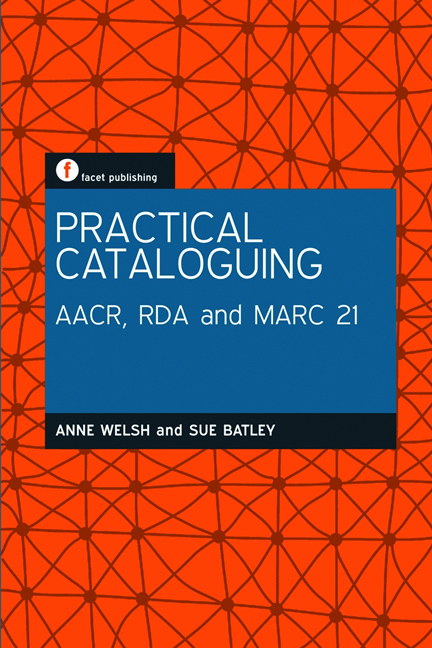Book contents
- Frontmatter
- Dedication
- Contents
- Acknowledgements
- Preface
- 1 Catalogues and cataloguing standards
- 2 The FRBRization of the catalogue
- 3 Bibliographic elements
- 4 Access points and headings
- 5 RDA: resource description and access
- 6 AACR and RDA
- 7 MARC 21
- 8 Practical cataloguing: bringing it all together
- 9 The birth of RDA and the death of MARC?
- 10 Examples
- References
- Index
6 - AACR and RDA
Published online by Cambridge University Press: 08 June 2018
- Frontmatter
- Dedication
- Contents
- Acknowledgements
- Preface
- 1 Catalogues and cataloguing standards
- 2 The FRBRization of the catalogue
- 3 Bibliographic elements
- 4 Access points and headings
- 5 RDA: resource description and access
- 6 AACR and RDA
- 7 MARC 21
- 8 Practical cataloguing: bringing it all together
- 9 The birth of RDA and the death of MARC?
- 10 Examples
- References
- Index
Summary
Introduction
Unsurprisingly, one of the frequently asked questions on the RDA website is ‘Will I have to make changes to my cataloguing records?’ The official answer given is:
The JSC agreed early on that records created by using RDA would be compatible with AACR2 records and that any instance where incompatibility might exist would be scrutinized very carefully before recommending a change. This commitment holds true today. But, there will be a few instances where headings will require modification, such as the headings for ‘Bible’. Using computers’ abilities for global updating will make these changes considerably easier than in preonline system days.
(Joint Steering Committee for the Development of RDA, 2010a)This chapter takes as its starting point an example record from Appendix M in the draft of RDA (Joint Steering Committee for the Development of RDA, 2008a and b) and compares it with a record produced under AACR2.
We are working from the text published on 31 October 2008, which the Joint Steering Committee issued as a draft and acknowledged contained typographic and other errors. We have corrected these in the light of the examples issued by the Library of Congress in 2011 (Library of Congress Cataloging and Acquisitions, 2011).
Example: Book 1
Taylor, Arlene G. The organization of information. 2nd ed. London: Libraries
Unlimited, 2004.
Table 6.1 on the following pages maps the information in Appendix M to the existing record on the Library of Congress website (Library of Congress, 2003). The information is listed in the order set by the RDA elements section of Appendix M. A blank space in the table means we could not find an equivalent.
Let us work through the equivalency table and discuss how it exemplifies the similarities and differences between RDA and AACR2.
Title proper
RDA 2.2.2 deals with the ‘preferred source of information’ – the new term for AACR2's ‘chief source of information’. RDA 2.2.2.2 specifies the preferred source for ‘Resources consisting of one or more pages, leaves, sheets or cards (or images of one or more pages, leaves sheets or cards)’. As a standard book, our title meets these criteria. There is no change here from AACR2 – we are instructed to ‘use the title page, title sheet, or title card (or image thereof) as the preferred source of information’.
- Type
- Chapter
- Information
- Practical CataloguingAACR, RDA and MARC 21, pp. 105 - 130Publisher: FacetPrint publication year: 2012



